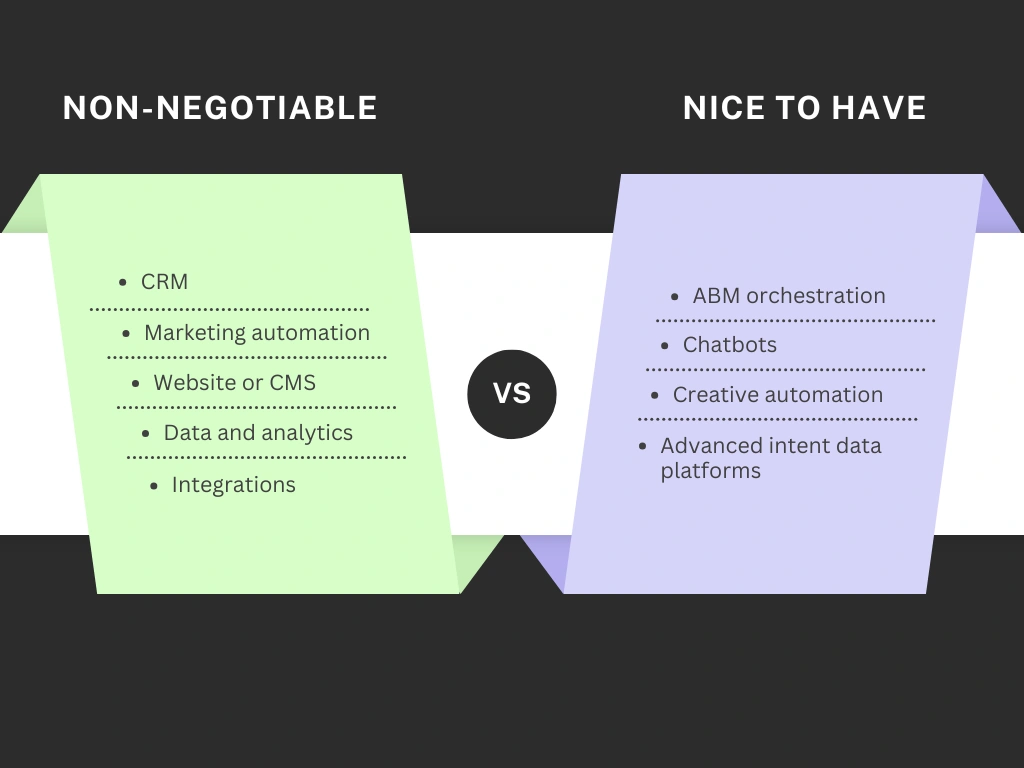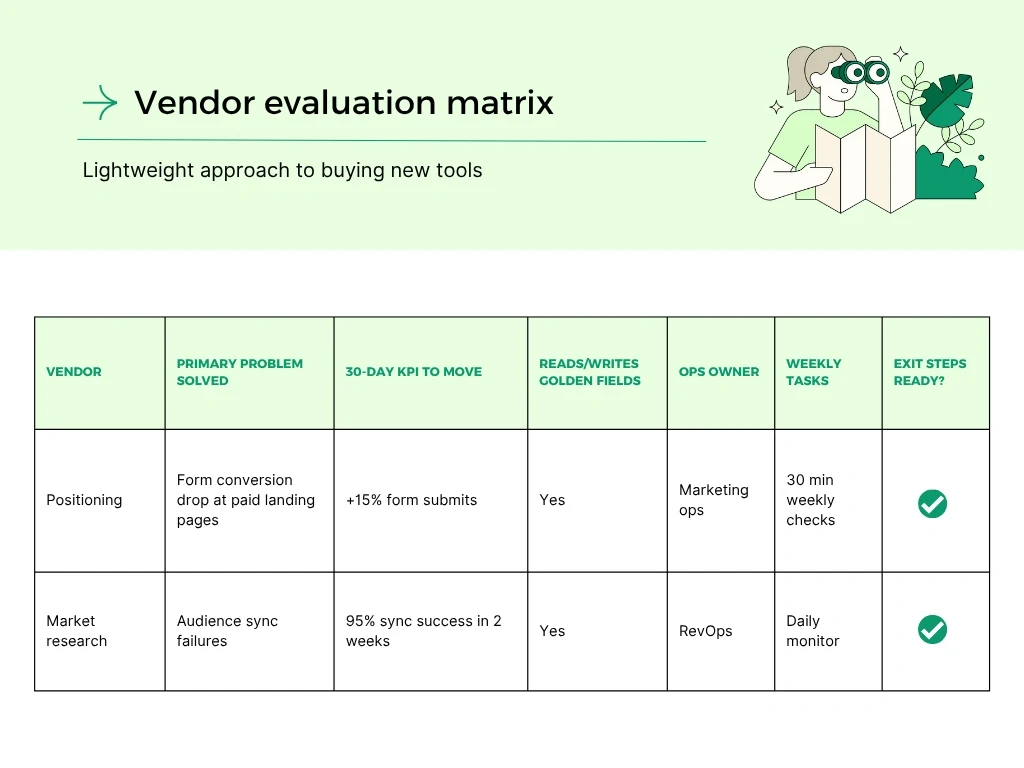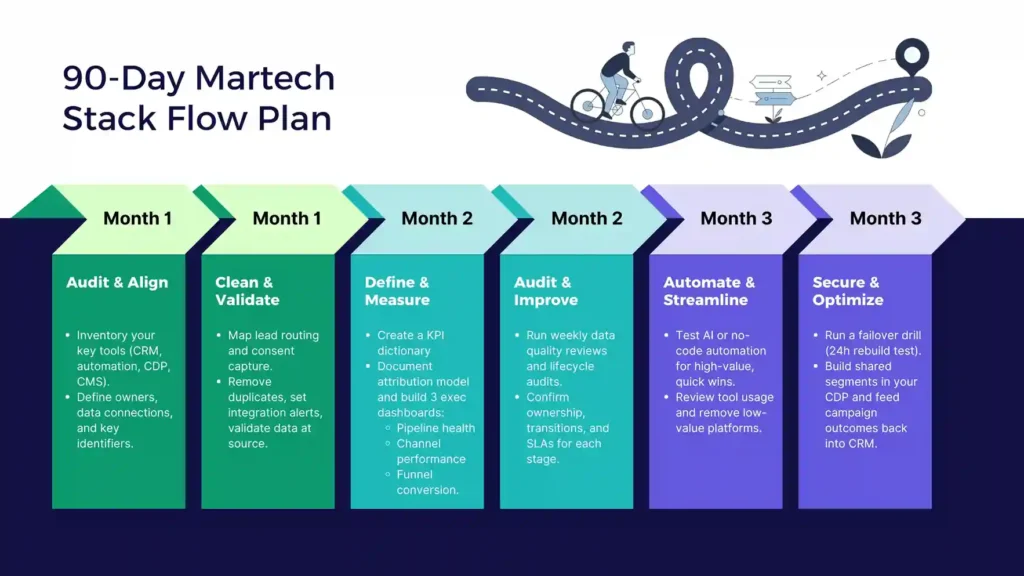Every marketing team wants a martech stack that drives revenue instead of slowing it down.
Too often, stacks get bloated with tools that don’t deliver value. We spoke with Ben Lack, CEO of Interrupt Media, to learn how to build a system that flows instead of blocks.
Define the mission: revenue flow in a constrained martech stack
Marketing is not short on software. It lacks flow, where signals move cleanly from first touch to revenue, with as few bottlenecks as possible and reliable team handoffs.
Treat your stack like a supply chain. If data and decisions cannot move through it quickly and accurately, the pipeline slows, costs rise, and trust in the numbers falls. When flow breaks, campaigns stall, channel teams argue over metrics, and sales stops relying on the system.
Ben’s north star is simple:
“Always start from the business goals. The stack should be a means to an end — not the other way around. We start with revenue objectives, target accounts, sales cycle length, and team capacity. Only then do we map tools against the journey. Otherwise, you risk building a Ferrari when what the client really needs is a pickup truck.”
Flow questions to answer before you buy anything:
- What revenue targets by segment must the stack support?
- Which motions, whether inbound, outbound, partner, or product-led, actually produce SQLs?
- Where does the sales cycle slow, and what specific data would remove that friction?
- Who will run what each week? Team capacity is part of the design.
- Which workflows must be measured end-to-end so that finance, sales, and marketing trust the same numbers?
How scaling changes your martech stack
In the early days, a martech stack’s role is to help companies move fast with limited resources — automating repetitive tasks, generating pipeline, and proving traction. As companies scale, the stack shifts from being purely about speed to being about control, visibility, and governance.
The enterprise stack isn’t just “what tools do we have?” but “how do we orchestrate these tools so that marketing, sales, customer success, and finance all have a single source of truth?”
For large teams, this means defining ownership, enforcing consistent reporting, and embedding guardrails. Without that, campaign timelines stretch, data silos form, and decision-making slows.
The foundation of a modern martech stack
Before adding specialized tools, focus on building the core system that everything else connects to.
Your “backbone” consists of key hubs that store and share reliable data across teams. Once these are in place, secondary tools can plug in more safely.
Ben’s design rule:
"We use a ‘hub-and-spoke’ model. Choose one or two anchor platforms — usually the CRM and marketing automation — and make sure every other tool integrates cleanly into those hubs. Best-of-breed is fine if you have a clear data architecture and ownership. Otherwise, it becomes duct tape and wishful thinking."
Non-negotiable vs. nice to have
Every business should start with the foundations: CRM, CMS, marketing automation, and analytics. Once the core infrastructure is established, you can add value with ‘nice-to-have’ tools like chatbots, ABM orchestrators, etc.

- iPaaS: An integration platform that connects apps and automates workflows. Think of it as the conveyor belt that keeps data moving.
- CDP: A customer data platform is used to unify data into person and account profiles, build audiences, and feed those audiences into downstream tools.
Your minimum viable backbone:
- CRM as the commercial record for accounts, contacts, opportunities, and activities.
- Marketing automation for orchestration, lead capture, email, and scoring logic that you can explain in plain language.
- Analytics in a warehouse or CDP, plus BI, so every team queries one truth.
- iPaaS or workflow automation to connect systems, with retries, alerting, and logs you can audit.
- Website or CMS as the public surface and primary capture point.
Pro tip: Do not confuse breadth with strength. Many companies run large app portfolios. Without a backbone and ownership, sprawl multiplies failure points and blocks flow.
Where martech stacks fail: overspending and underinvestment
Supply chains fail at the weakest link. Stacks do as well. Ben sees the same pattern at many companies: teams overspend on shiny features and starve analytics.
“In tools that promise “shiny object” features like predictive scoring or generative content before they’ve nailed basics like clean data, lead routing, and reporting. I’ve seen companies spend six figures on intent platforms while their Salesforce instance is full of duplicates.”
On the flip side:
“Reporting and analytics. Everyone says they want to be data-driven, but very few companies actually fund the talent and tools to build meaningful dashboards. Without that, it’s impossible to prove ROI or make smart budget calls.”
Benchmark snapshot: According to recent SaaS spend reports, companies are increasing app counts again, yet fewer than half actively monitor tool usage or data flow. This creates hidden costs and integration risk. Without visibility, analytics and decision-making degrade quickly.
What this looks like day to day:
- Reporting takes longer than campaign creation.
- Tools overlap in purpose but don’t share data.
- Key dashboards are maintained manually, not automated.
- No clear owner exists for data accuracy or governance.
- Budgets rise, but team efficiency doesn’t.
Spotting flaws in your stack early
You do not need a maturity model to see when the stack is working against you. Listen to the people doing the work and track cycle time.
Ben’s diagnostic checklist is simple:
“Long campaign launch times, lack of trust in the data, and sales saying, “I don’t use the system.” If it takes two weeks to launch an email campaign or leadership spends meetings debating whose numbers are right, your stack is working against you.”
What to track regularly:
- Time from campaign brief to first send.
- Alignment of MQL, SAL, and SQL definitions across departments.
- Duplicate rate per account/contact.
- Integration failure alerts or null field frequency.
These are not training issues. They are architecture, ownership, and data quality problems. Fix the spine and adoption will rise.
Prepare for the next five years
The next five years will reshape marketing operations. AI and no-code tools speed up execution, but only clean, governed data keeps them reliable. Layering automation on a weak process only creates faster mistakes.
Ben’s guidance:
“Focus on agility and data hygiene. AI and no-code tools will accelerate execution, but only if the data is accurate and the workflows are documented. Privacy regulations will get stricter, so governance has to be built in, not bolted on. The winners will be CMOs who can adopt new tools quickly without creating compliance or integration debt.”
Two realities to design around:
- EU AI Act: Obligations for general-purpose AI models begin in 2025, with broader high-risk requirements following. If you embed AI into targeting, scoring, or content, include model provenance, evaluation, and human review in your runbooks.
- Third-party cookies: Even with shifting timelines, do not rely on them. Double down on first-party data with clear consent and transparent value exchange.
AI governance checklist:
- Keep a registry of AI use cases, prompts, models, and data sources.
- Store evaluations for output quality and bias, plus human review steps.
- Log prompts and versions so you can reproduce results.
- Document opt-out flows for customers and employees where relevant.
No-code guardrails:
- Restrict who can publish workflows to production.
- Require change tickets for edits to routing or scoring.
- Version lists, scoring rules, and prompts with rollback.
A disciplined approach to buying new tools
When adding technology, your goal isn’t “more capabilities”; it’s removing friction.
Ben’s advice to overwhelmed buyers:
“Strip it back to first principles: what problem are we solving, and what outcome do we need? Don’t buy a tool because a competitor has it or because it showed up in a quadrant report. Buy it because it solves your team’s specific problem better than anything else you’ve tested.”
Four simple evaluation tests:
- Golden record test: Can this tool read and write customer data without creating duplicates or breaking IDs?
- Time-to-value test: Can you measure improvement on a KPI (like conversion or response rate) within 30 days?
- Operations fit test: Can your current team maintain it weekly, or are you buying a new workload?
- Exit test: Can you export your data and rebuild the connection if the vendor folds or changes terms?
Golden record: A unique, authoritative profile of a customer or account, used as the source of truth across systems.

Lightweight vendor evaluation matrix
Exit plan: In this context, an exit plan is a strategy for exporting and rebuilding data flows and integrations if you migrate tools.
The 90-day martech stack flow plan
No theater. Just moves that restore speed and data trust.

Month 1: Stabilize
- Inventory your core tools: CRM, marketing automation, analytics/CDP, iPaaS, CMS. Identify owners and data connections.
- Define your key identifiers (account and contact IDs). Create a field dictionary for top fields and confirm ownership.
- Map lead routing and consent capture from form to assignment.
- Clean duplicates and set up alerts for integration errors.
- Validate data at the source (forms, imports, APIs).
Month 2: Instrument
- KPI dictionary. Set exact definitions for MQL, SAL, SQL, win, CAC, and LTV. Store them in your analytics layer so every report uses the same math.
- Three executive dashboards.
- Pipeline health with coverage, age, and conversion by stage and segment.
- Channel performance from spend to SQL to revenue.
- Funnel conversion from first touch to win by segment.
- Pipeline health with coverage, age, and conversion by stage and segment.
- Document your attribution model. Clarity matters more than perfection.
- Begin weekly data quality reviews: duplicates, nulls, routing errors.
- Run a lifecycle audit to confirm transitions, ownership, and SLAs for each stage.
Month 3: Accelerate
- Test AI or no-code automation for small, high-value tasks like subject-line testing or routing notes.
- Review tool usage and remove anything with low adoption or unclear value.
- Conduct a failover drill: export data and ensure critical connections can be rebuilt within 24 hours.
- Build shared audience segments in your CDP or analytics layer.
- Feed campaign outcomes back into the CRM to complete reporting loops.
Final word: flow beats features
The best martech stacks do not look flashy. They move. They turn signals into revenue with less waste because the backbone is strong, the data is trustworthy, and the team can change the system without breaking it.
Ben’s takeaway:
“Many clients think the perfect stack is the one with the most logos on the slide. They assume more tools equals more capability. In reality, a bloated stack usually creates silos, duplicate data, and low adoption. The perfect stack is the one that actually gets used, integrates cleanly, and directly supports the company’s go-to-market strategy.”
Build for flow, not features.







